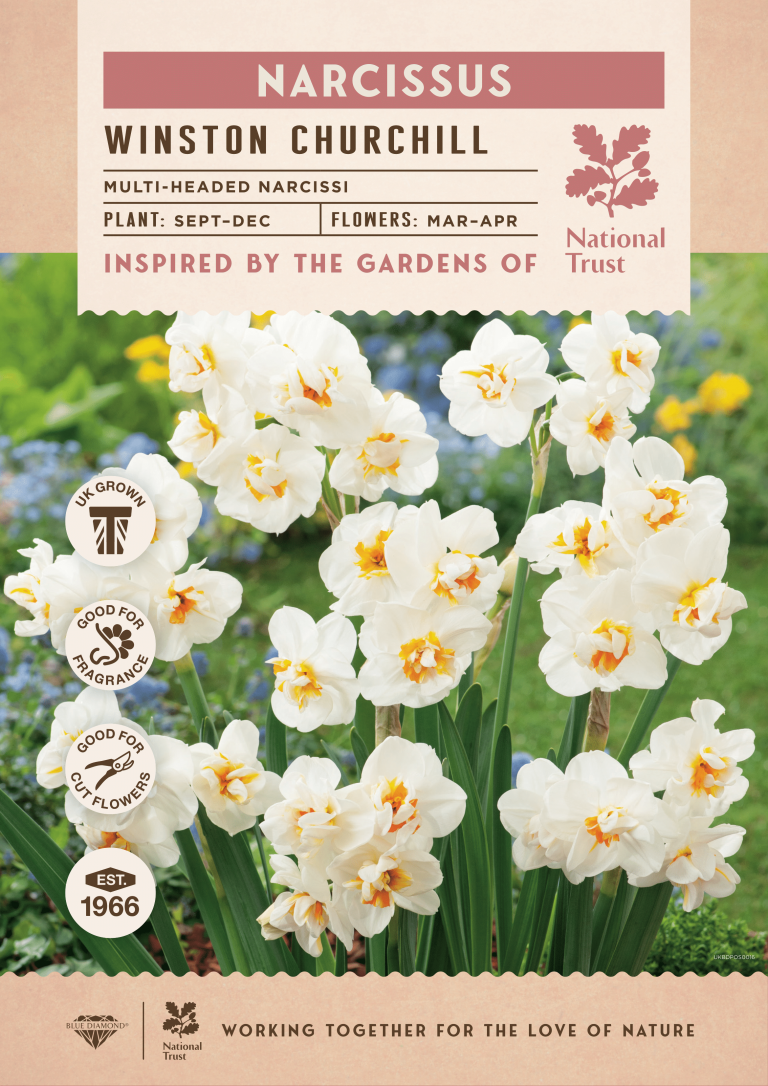Daffodils
No other flower heralds spring quite like the daffodil. The UK is the world’s biggest grower of daffodils – so it's not surprising they have such a significant place in our gardening history and culture.
From Wordsworth’s golden daffodils in Cumbria to the cut-flower industry in Cornwall, daffodils are woven into the stories of many National Trust places.

The origins of narcissus
The botanical name for the daffodil is narcissus, the name given to the beautiful youth in Greek mythology who was tricked into falling in love with his own reflection. The drooping flowers which characterise most daffodils are said to recall Narcissus bending over to catch his image in a pool of water. The name derives from the Greek narco, root of the word narcotic. The etymology probably relates to the daffodil's toxicity – all parts of the plant are poisonous. Florists and daffodil pickers are familiar with the rash that can be caused when the stalk's sap comes into contact with the skin.
The Romans are known to have planted narcissus in memory of loved ones or comrades fallen in battle and are likely to have brought daffodils to Britain from the Iberian pennisula, predominantly Spain and Portugal, where the largest variety of daffodil species can be found.
Photo Credit: Rijksmuseum (Free Public Domain Usage)

Every shade of yellow
National Trust Daffodil Collections
From rare heritage varieties at Cotehele and Saltram along the Tamar valley to a daffodil memorial at Dora's Field in the Lake District, daffodils have played an important role in the history of many National Trust places. Below are some of their most significant collections.
Acorn Bank, Cumbria
Image credit: ©National Trust Images/Jo Whitworth
Swathes of daffodils fill the walled garden and woods around Acorn Bank in spring, the legacy of Dorothy Una Ratcliffe who gave Acorn Bank to the National Trust in 1950. A wealthy socialite, prolific writer and keen gardener, Dorothy planted thousands of bulbs in the 1930s, including some of the earliest varieties such as ‘Telamonius Plenus’, a double daffodil dating to the 17th century. She was so fond of the flower that she asked friends to remember her as the ‘lady of a million daffodils’. From early April through to May, the garden feels as though it's honouring Dorothy’s memory with a sea of flowers.
Cotehele, Cornwall
Image credit: ©National Trust Images/Carole Drake
Cotehele is home to the most significant collection of historic daffodils in the National Trust and one of the most important nationally. Varieties such as ‘Coverack Pride’, ‘Saint Issey’ and ‘Scilly White’ reflect their Cornish heritage, while ‘Van Sion’, ‘Orange Phoenix’ and 'Grand Soleil d’Or’ are some of the oldest daffodils recorded. A restored packing shed where daffodil growers once prepared flowers to be sent ‘up country’, tells the story of the enduring influence of daffodils on the Tamar valley landscape.
Saltram, Devon
 Our collaboration with the National Trust will focus on conserving plants from their collections, including daffodils. We will work with growers to procure and protect unique varieties, so they can be grown and sold for the enjoyment of everyone. Included in the daffodil bulb collection, are unique varieties such as the ‘Saltram’ daffodil which will be launched across all Blue Diamond Garden Centres.
Our collaboration with the National Trust will focus on conserving plants from their collections, including daffodils. We will work with growers to procure and protect unique varieties, so they can be grown and sold for the enjoyment of everyone. Included in the daffodil bulb collection, are unique varieties such as the ‘Saltram’ daffodil which will be launched across all Blue Diamond Garden Centres.
Through sales generated from the National Trust Collection by Blue Diamond, a minimum of 10% of the retail sales price per product will be given to the National Trust to help look after nature, beauty and history for everyone, forever.
A selection of varieties currently found in National Trust gardens, and available to purchase instore now:

Daffodil ‘St Keverne’
Early to flower, this large showy golden trumpet variety of daffodil is long lasting and eary to grow.
Tolerates most soils that are well-drained, but remain moist during the dormant season.
Ideal for naturalising in beds and borders.
Family Amaryllidaceae
Native to the UK No
Foliage Deciduous
Habit Bushy
Potentially harmful Ingestion may cause severe discomfort, and skin irritants. Wear gloves and other protective equipment when handling
Genus Narcissus are bulbous herbaceous perennials with linear leaves and leafless stems bearing flowers, which may be solitary or in umbels, with 6 spreading perianth segments and a cup or trumpet-shaped corona
Name status Accepted
Horticultural Group Large-cupped daffodils have solitary flowers in which the cup is at least one third as long as, but shorter than, the perianth segments

Narcissus ‘Winston Churchill’
Winston Churchill is highly recommended with its unmistakable and enchanting fragrance, the double white multi-headed narcissus in easy to grow and long-lasting, making the perfect cut flower.
Charming, dainty white flowers with orange-yellow centres that are excellent for planters, beds and borders.
Plant a handful in a pot and bring it indoors when in bloom for the perfect, natural room fragrance.
Family Amaryllidaceae
Native to the UK No
Foliage Deciduous
Habit Clump forming
Potentially harmful Ingestion may cause severe discomfort, skin irritant. Wear gloves and other protective equipment when handling
Genus Narcissus are bulbous herbaceous perennials with linear leaves and leafless stems bearing flowers, which may be solitary or in umbels, with 6 spreading perianth segments and a cup or trumpet-shaped corona
Name status Accepted
Horticultural Group Double daffodils may have one or more flowers per stem, with either perianth segments or corona, or both being doubled

Daffodil ‘Ice Follies’
Still as popular today as it was in the early 1950’s - this yellow-flowered daffodil soon turns white after opening.
Prolific and easy to grow ideal for pots or for naturalising.
An ideal cut flower variety with a medium to light fragrance. Flowers mid season from March onwards.
Family Amaryllidaceae
Native to the UK No
Foliage Deciduous
Habit Bushy
Potentially harmful Ingestion may cause severe discomfort, and skin irritants. Wear gloves and other protective equipment when handling
Genus Narcissus are bulbous herbaceous perennials with linear leaves and leafless stems bearing flowers, which may be solitary or in umbels, with 6 spreading perianth segments and a cup or trumpet-shaped corona
Name status Accepted
Horticultural Group Large-cupped daffodils have solitary flowers in which the cup is at least one third as long as, but shorter than, the perianth segments
Explore daffodil walks at your local National Trust




